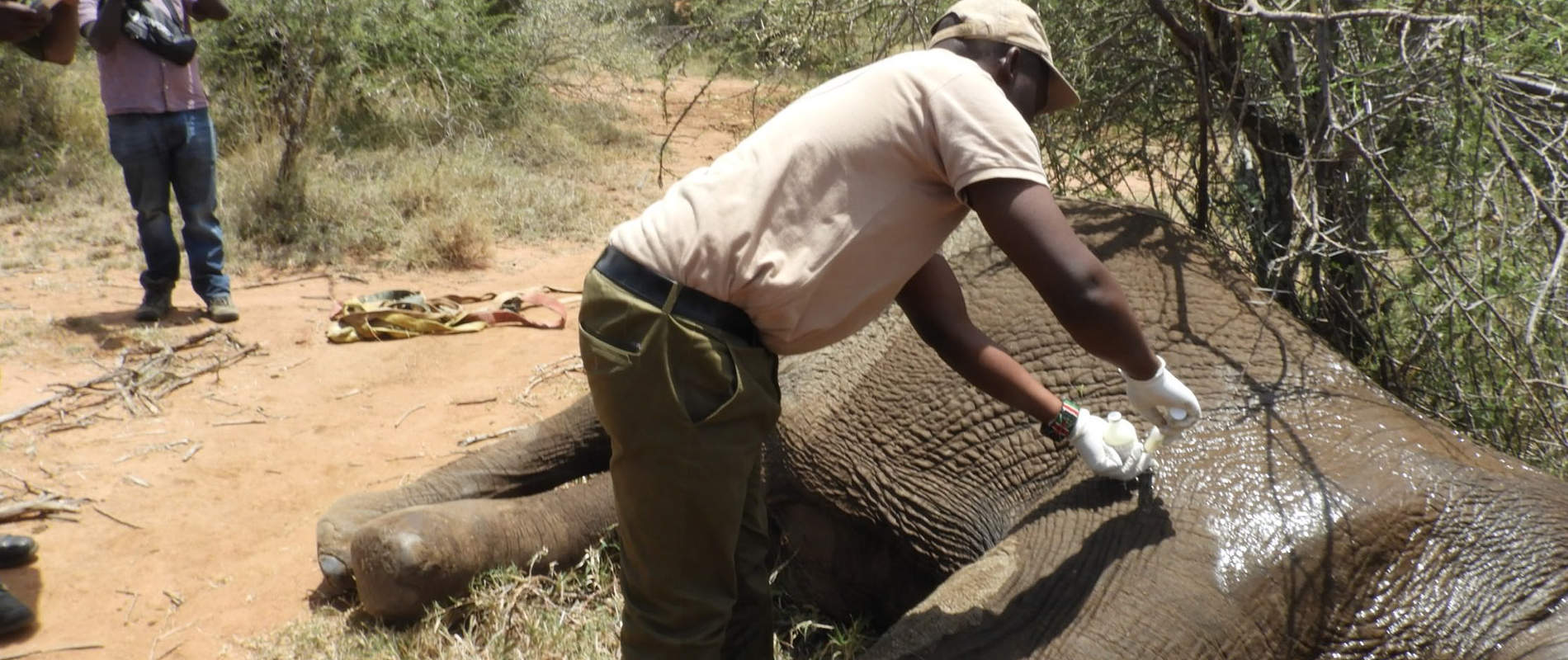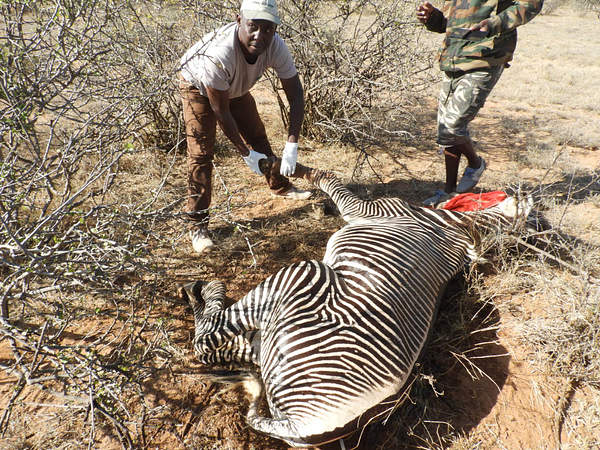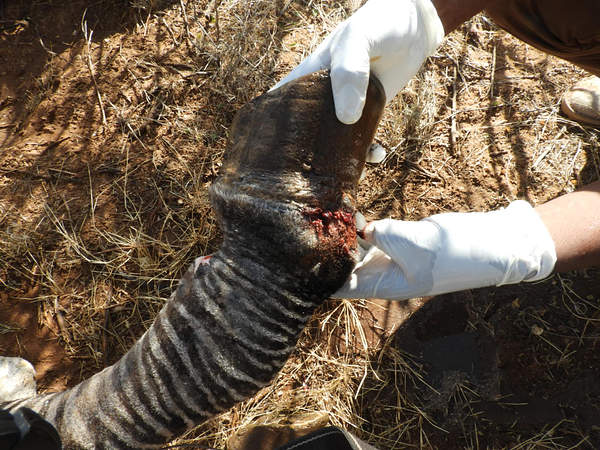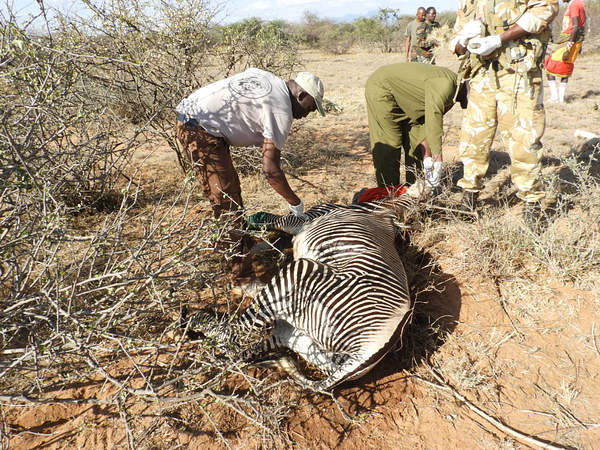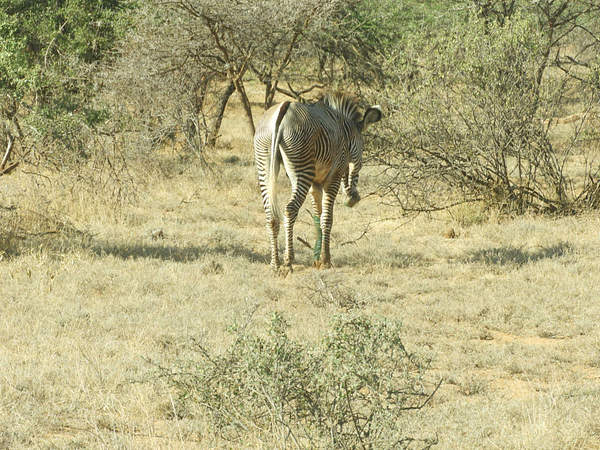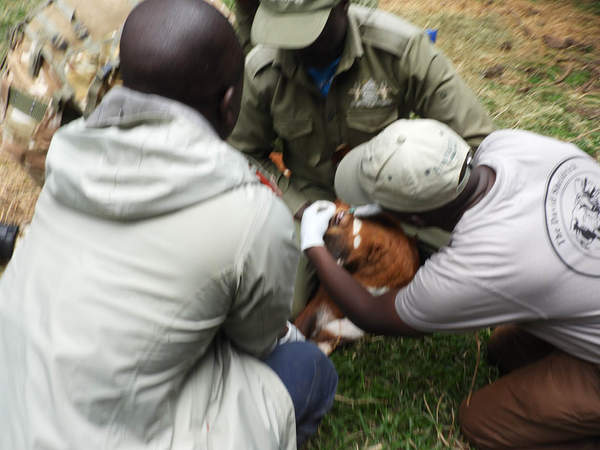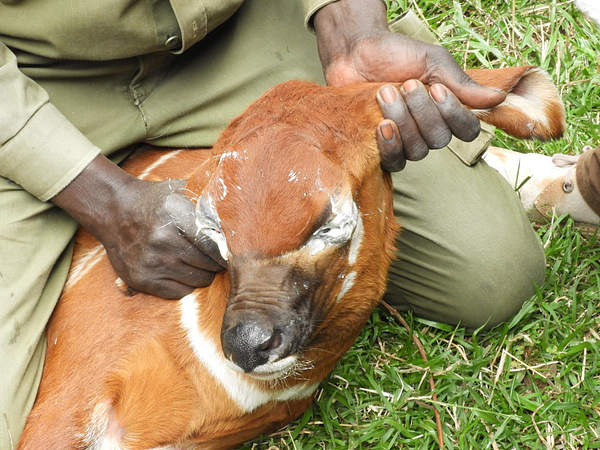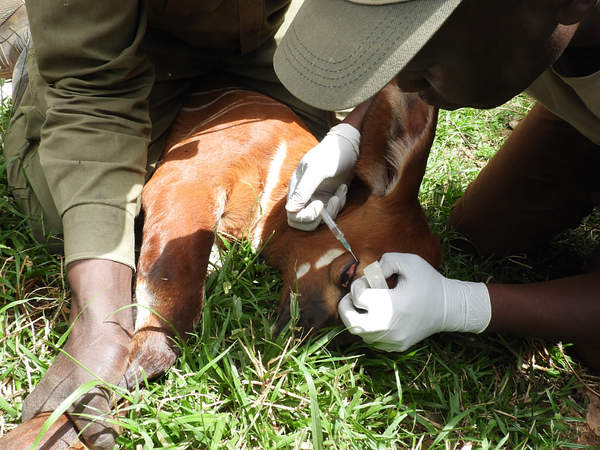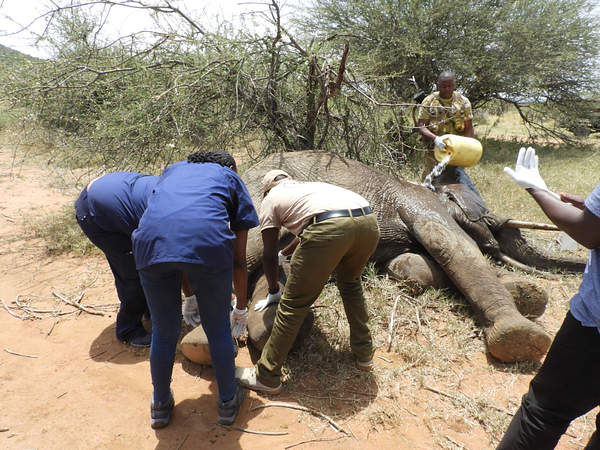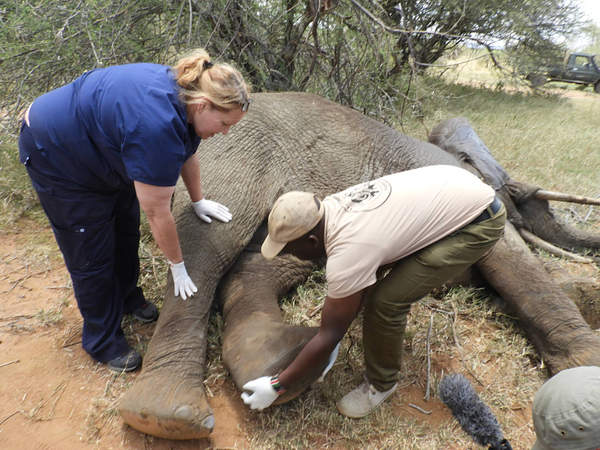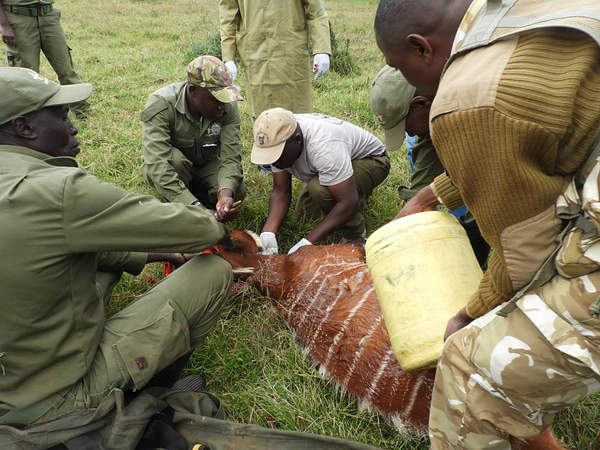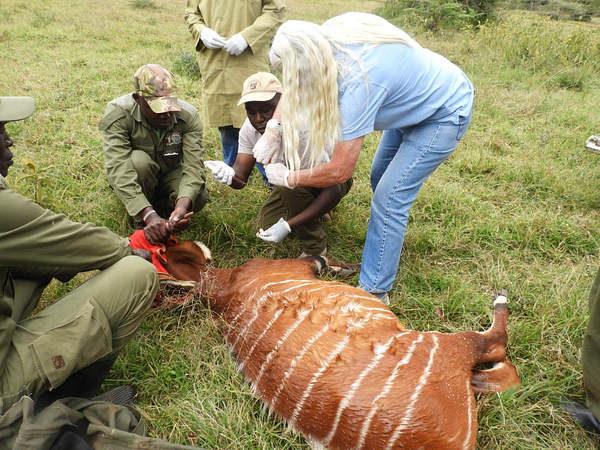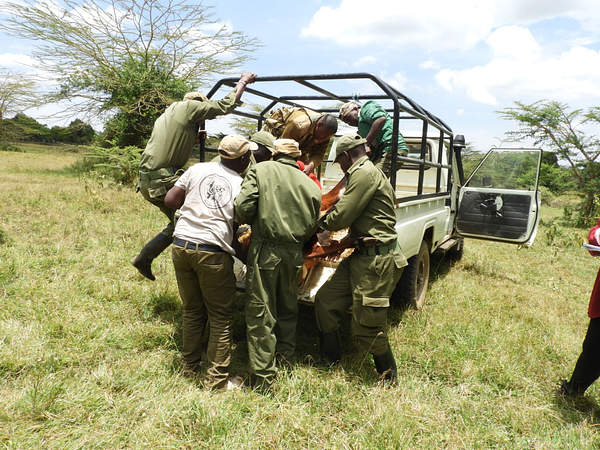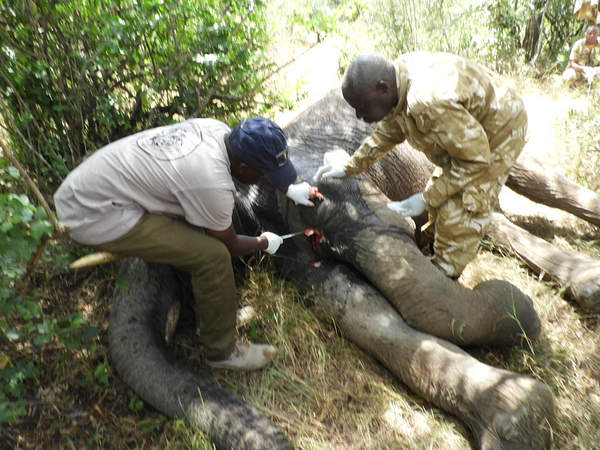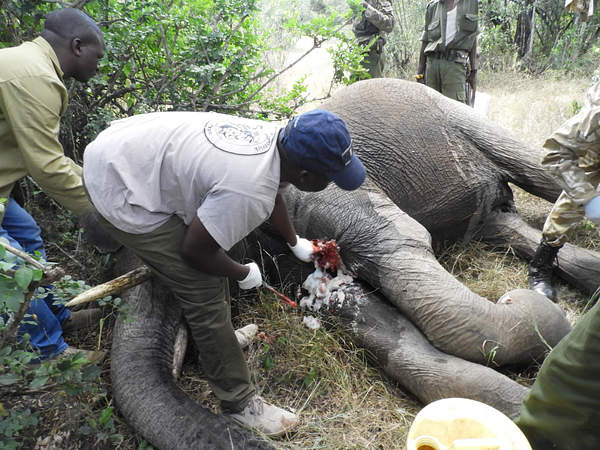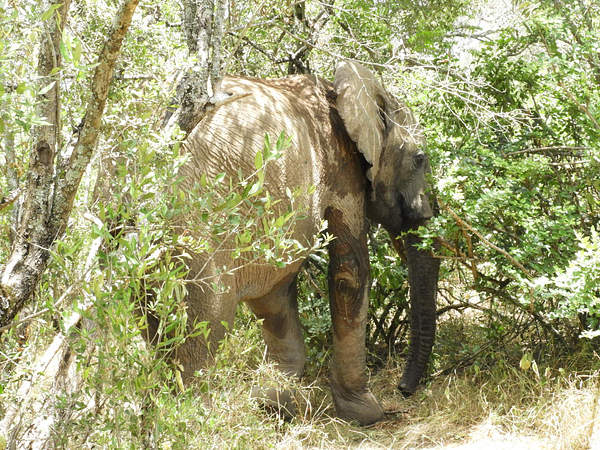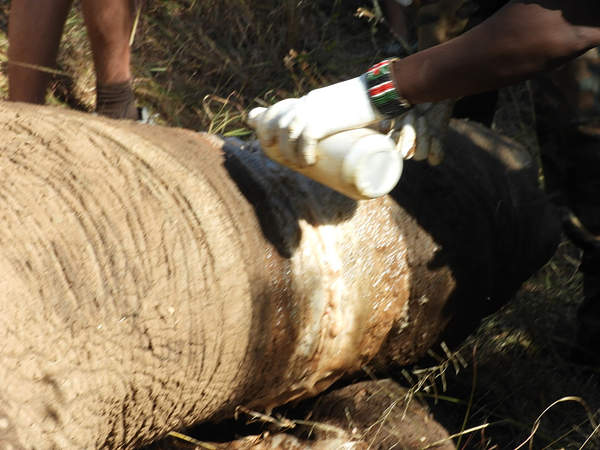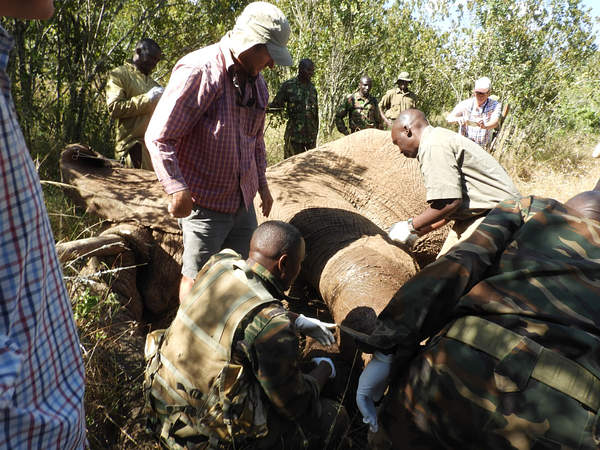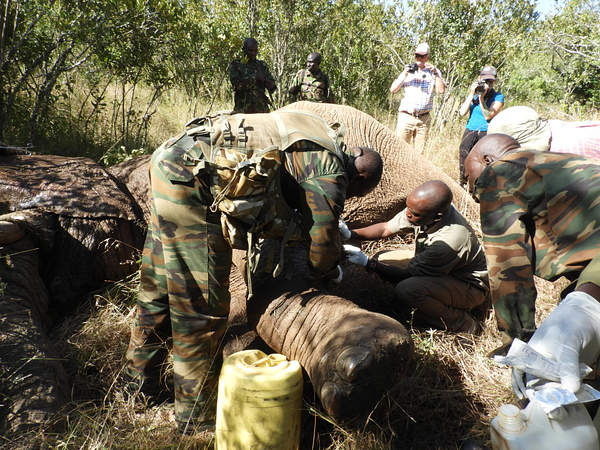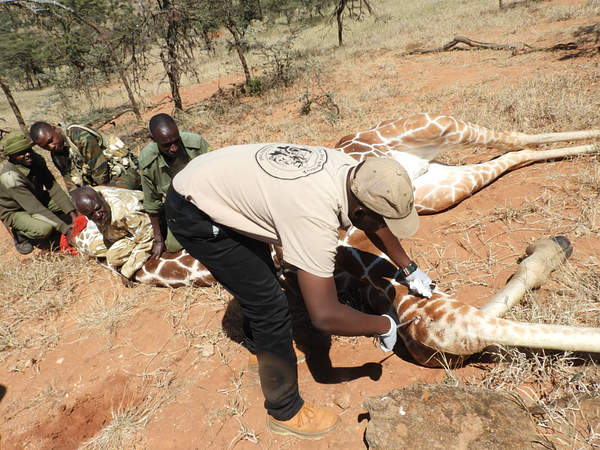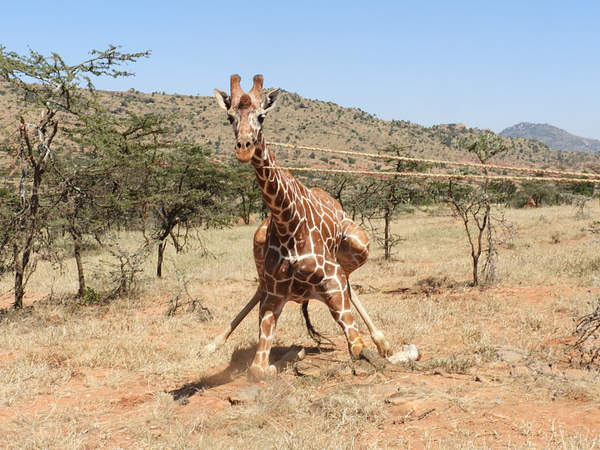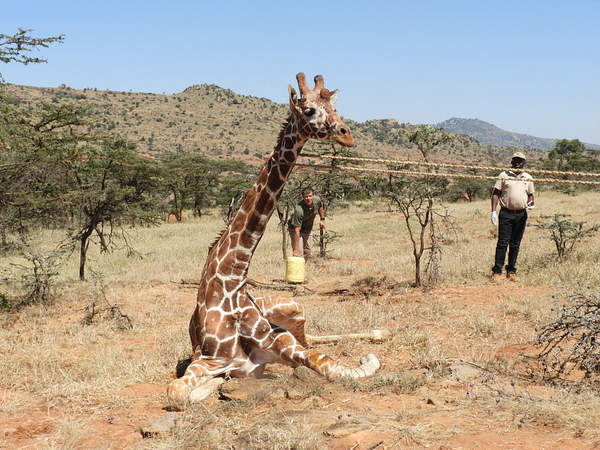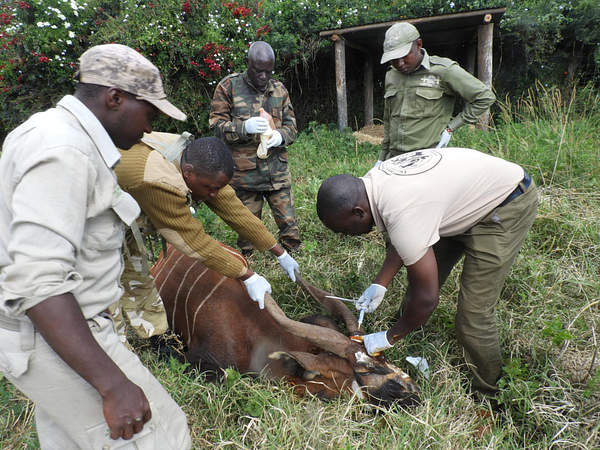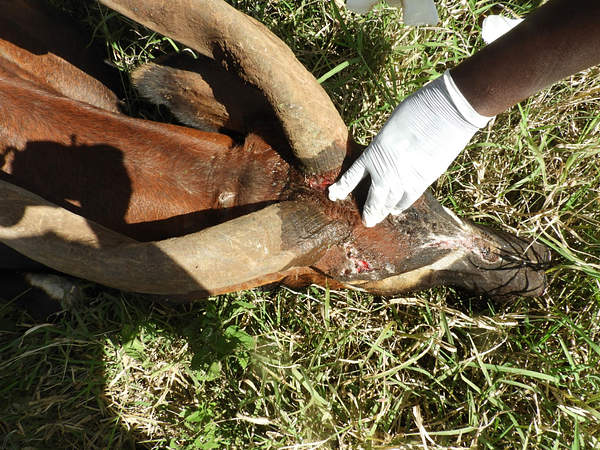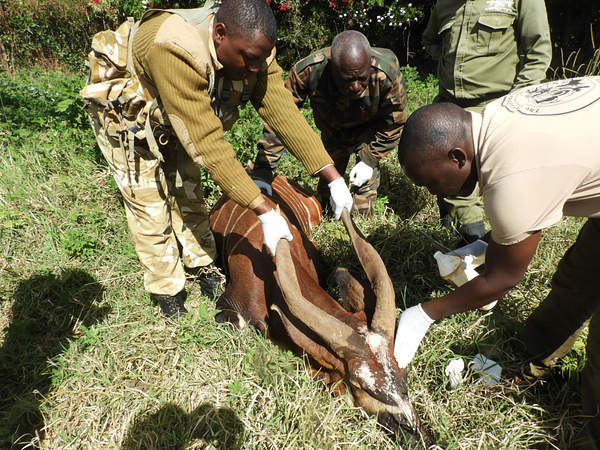The Mt Kenya Wildlife Veterinary unit attended to several wildlife cases that required urgent veterinary intervention in the whole of Laikipia-Samburu ecosystem and Mt. Kenya region during the month of September, 2018.
Case #1: Treatment of an injured male Grevy zebra
Animal Identification
Species: Grevy’s zebra (Equuis grevyi)
Sex: Male
Age: Adult
Location: Ol donyiro, Isiolo County
History: This was a case of an adult male Grevy zebra reported to be limping and bleeding on its left front leg.
Immobilization, examination & treatment: The injured zebra was found limping alone in a fairly open field, it was quite weak and slow due to intense pain from the injury. The team was able to track it by a vehicle and it was successfully darted from a vehicle using 4mgs of etorphine Hcl combined with 80mgs of azaperone delivered by Dan-inject remote delivery system.
The animal was suspected to have been caught on a tight snare and escaped with lacerative wounds around the carpal joint and the leg had a closed fracture that had formed callus and beginning to heal. The wounds were cleaned with lots of water, cauterized and debrided using 10% Hydrogen peroxide and thereafter covered with povidone iodine. Further topical treatments included application oxytetracycline spray to enhance the healing process.
Other treatments using Amoxycillin (Betamox®) was administered and dexamethasone anti-inflammatory drug administered intramuscularly to enhance wound healing process.
Reversal and prognosis: The anaesthesia was revived using 12mgs of diprenorphine Hcl administered through the jugular vein. The zebra rose up after 1 minute and ran away feeling relieved. Prognosis was fair and KWS rangers and community scouts were informed to monitor and report.
Case#2: Treatment of a Juvenile bongo with Keratoconjuctivitis (eye infection)
Animal identification:
Species: Mountain bongo (Tragelaphus eurycerus isaaci)
Sex: Female
Age: Juvenile
Location: Mount Kenya Game Ranch
History: A two-month old Mountain bongo was reported to have bilateral swelling of both eyes and was becoming blind and very much irritated, this required urgent veterinary intervention.
Examination and treatment: The young animal was physically restrained by hand then treated then the eyes were closely examined. It had a very severe keratoconjuctivitis most likely caused by bacterial infection. It was treated by injection of Amoxycillin (Betamox®) combined with dexamethasone administered through the intra-conjuctival route. Different syringes and needles were used for each eye to avoid cross-infection of the eyes. Cloxacillin (Opticlox®) eye ointment was then applied topically.
Blood samples were also collected for further investigations and health monitoring. Application of eye ointment was repeated three times at an interval of every 3 days. Intramuscular injection of Amoxycillin (Betamox®) and multivitamin was also given.
Prognosis: Prognosis was good after treatment and the animals will be monitored daily by the keepers.
Case #3: Repeat treatment of an injured male elephant
Species: African Elephant (Loxodanta africana)
Sex: Male
Age: Approximately 15 years old
Location: Mpala Wildlife Conservancy
History: This was a repeat treatment a sub-adult male elephant in Mpala Wildlife Conservancy that was suspected to have sustained a fracture or dislocation of the left hind leg. The elephant had made quite good improvements after the first treatment about a month ago, but it required re-examination and repeat treatment to enhance its recovery.
Immobilization, examination & treatment: The injured elephant was darted from a vehicle using 12mgs of etorphine Hcl in a 2ml Dan-inject dart. The elephant was immobilized after about 6 minutes and went down on sternal recumbency. Ropes were used to pull it down on lateral recumbency.
The affected left hind leg was still stiff and not flexing, it had no wound or any other external injury on the affected leg. The elephant was then treated with Vitamin B12 and Calcium (Calciject®) followed by Dexamethason injection and Betamox® antibiotic administered intramuscularly to reduce pain and treat possible internal infection as the recovery process continued. This was the same treatment as last time and it had made very good improvements.

Reversal and prognosis: Soon after treatment, the elephant was revived from anaesthesia using 36mgs of diprenorphine Hcl combined with 50mgs of Naltrexone administered intravenously through the superficial ear-vein. The elephant rose up shortly and walked away feeling much relieved. Prognosis was good as it had responded quite well to the previous treatment and expected to recover fully after the second treatment. The elephant is being closely monitored by the security team at the Mpala Conservancy who have reported good progress.
Case #4: Treatment of an adult female elephant
Species: African Elephant (Loxodanta africana)
Sex: Female
Age: Approx. 35 years old
Location: Mpala Wildlife Conservancy
Date of clinical intervention: 25/9/2018
History: The elephant was sighted with a large rounded swelling on the latero-ventral side of the right abdomen. The swelling looked like a fresh wound with slight haemorrhages and covered with thin layer of necrotic tissues.
Immobilization, examination & treatment: The elephant was darted using 15mgs of etorphine Hcl in Dan-inject dart. The elephant got adequately immobilized after about 7 minutes and went down on lateral recumbency.

The swelling was palpated by hands and then aspirated by a needle and syringe; it was a well consolidated lump of live tissue that was fresh and growing. Any slight cut on the swelling led to profuse bleeding and revealed live tissues parenchyma. The swelling seemed to have grown over time and was still growing. Morphologically it was confirmed to be a cancerous growth of the skin, probably a benign tumor. Attempts to excise (cut it off) proved futile due to excessive haemorrhage and prolapsed of abdominal organs (intestines).
Tissue samples were collected from the swelling and preserved in ethanol and some parts frozen for histopathology tests to confirm which type of cancer this is. Blood samples were also collected and preserved by freezing.
The wound on the swelling was then debrided with 10% hydrogen peroxide then cleaned and flushed with tincture of Lugol’s iodine. It was further treated using oxytetracycline spray and green clay applied.
Other treatments were intramuscular injection of Procaine penicillin (Norocillin®) and dexamethasone to reduce inflammation and swelling.

Reversal and prognosis: Prognosis was quite poor due to the intensive pain and haemorrhage from the swelling and also the likelihood of metastasis of the cancerous cells. However, it will still continue with supportive therapy to manage the wound.
Our mobile vet initiative is in the field every day saving wild lives
Case# 5: Treatment and relocation of two Mountain Bongo antelopes
Species: Mountain bongo (Tragelaphus eurycerus isaaci)
Sex: 2 Females
Age: Adult
Location: Mount Kenya Game Ranch
History: The management of Mt Kenya Game ranch requested the veterinary unit to help in chemical immobilization, capture, samples collection and treatment of 2 adult female mountain bongos which were in deep thicket and very much isolated from the rest of the herds. They were at security risk and could not be accessed by males for breeding purposes.
Chemical Immobilization and relocation: The two bongos were approached and darted on foot using 5mgs of etorphine Hcl combined with 50mgs of azaperone one at a time.
The bongos were put on a stretcher and carried by people then loaded onto a pick-up van padded with hay and driven to another enclosure about 3 kilometers away. The team kept on pouring water on the animals to ensure they were in stable condition during the relocation process.
Collection of samples and treatment: Soon after off-loading blood samples were collected from the jugular vein in EDTA coated tubes and plain tubes, tissue and tick samples were collected and preserved in 70% ethanol and blood smears were also prepared these will be preserved in the laboratory and later analysed as part of disease surveillance among the bongo population. A similar exercise had been undertaken earlier on 4 bongos.
The animals were given pre-treatment using antibiotics, multivitamins and ivermectin to manage possible infections and gastrointestinal parasites.
Reversal: The relocated bongos were then revived from anaesthesia using 18mgs of diprenorphine Hcl combined with 50mgs of Naltrexon administered through the jugular vein and released to the new enclosure where they can be easily monitored and participate in breeding with the rest of the herds.
Case#6: Treatment of an injured Sub-adult male elephant
Species: African Elephant (Loxodanta africana)
Sex: Male
Age: Sub-adult
Location: Loldaiga Wildlife Conservancy
Date of clinical intervention: 14/9/2018
History: This was a case of a sub-adult male elephant sighted by community scouts from Loldaiga Wildlife Conservancy in Laikipia County, it had deep penetrating wounds on the medial side of the left front leg. The elephant was left lonely in the deep thickets of Loldaiga hills and could be seen limping and remained isolated from the rest of the elephant herds.
Immobilization, examination & treatment: The injured elephant was found in a thicket forest where it was tracked for several hours on foot and eventually it was darted on the right rump muscles using 15mgs of etorphine Hcl in a 2ml Dan-inject dart. The elephant was followed on foot until it got adequately immobilized after about 10 minutes and went down on sternal recumbency, the team later pushed it over on lateral recumbency for effective treatment.
The elephant had deep penetrating wounds on the medial side of the left front leg. The wound was quite septic with lots of pus and exudates and necrotic tissue debris. The wound was cleaned with lots of clean water then probed using sterile gauze swabs attached to long forceps to remove all the necrotic debri and ensure no foreign material was left inside.
Thereafter the wound was then debrided with dilute 10% hydrogen peroxide then cleaned and flushed with tincture of iodine. It was further treated using Opticlox® ointment applied topically and oxytetracycline spray applied. Other treatments were intramuscular injection of Procaine penicillin (Norocillin®) and dexamethasone to support the wound healing process.
Reversal and prognosis: After treatment, the elephant was then revived from anaesthesia using 48mgs of Diprenorphine Hcl administered intravenous through the superficial ear-vein. It rose up with difficulties and walked away into the thicket.
Prognosis was quite good after treatment and quick recovery was expected since the wound was higher up with minimum contamination and only affected soft tissues. The security rangers at Loldaiga were informed to monitor the progress and report to the veterinary team in case it required repeat treatment.
Case#7: Treatment of an injured adult male elephant
Species: African Elephant (Loxodanta africana)
Sex: Male
Age: Adult
Location: Mugie Wildlife Conservancy
Date of clinical intervention: 17/09/2018
History: This was a case of an adult male elephant sighted in Mugie Wildlife Conservancy, it was quite weak, limping and unable to move, the left front leg was weak and heavily swollen at the carpal joint and could not support the body. It had minor external injuries around the swollen leg and the elephant was still in good body condition.
Immobilization, examination & treatment: The sick elephant was found a deep thicket while moving slowly, it was then darted using 18mgs of etorphine Hcl in a 3ml Dan-inject dart. The elephant got immobilized after about 6 minutes and went down on lateral recumbency.

There were minor visible traumatic injuries around the swollen leg, the affected leg was flexed and palpated thoroughly. It was suspected to have sustained partial bone fracture or dislocation around the carpal joint, this injury caused inflammation and a lot of pain hence the elephant could barely move. The cause of the injury could not be established.
The elephant was then treated with Calcium injection (Calciject®), Vitamin B12 and dexamethasone injection to revitalize the nerves and reduce pain on the joint, further treatment with long-acting Betamox® antibiotic intramuscularly to treat possible internal infection.
Reversal and prognosis: The elephant was then revived from anaesthesia using 48mgs of diprenorphine Hcl combined with 50mgs of Naltrexone administered intravenous through the superficial ear-vein. The elephant rose up after two minutes and moved away slowly feeling a bit relieved.
Prognosis was guarded due to pain and its inability to move but it had good appetite and remained near the water source hence it has good chances of recovery. The elephant has since improved and moved away from the area where it was treated.
Case #8: Treatment of an injured adult male giraffe
Species: Reticulated giraffe (Giraffa camelopardalis)
Sex: Female
Age: Adult
Location: Olenashu Wildlife Conservancy
History: An adult male giraffe was reported to be limping and had open wounds on the right front leg. The animal was quite weak and could not keep pace with other giraffes hence required immediate veterinary intervention.
Immobilization, examination & treatment: The injured giraffe was found browsing in a fairly thicket area from where it was darted from a vehicle using 12mgs of etorphine Hcl combined with 50mgs of azaperone delivered by Dan-inject remote delivery system. It took about 11 minutes for the immobilization drug to take effect and the giraffe was roped down by the veterinary team assisted by the team at the conservancy.
The giraffe had a deep wound on the right carpal joint that affected the joint capsule, the wound had lots of pus, exudates and necrotic tissue debris. The wound was cleaned with water then cauterized and debrided using 10% Hydrogen peroxide and thereafter covered with Lugol’s iodine.
Further treatments included application of opticlox ointment then oxytetracycline spray. Amoxycillin (Betamox®) was administered and dexamethasone anti-inflammatory drug administered intramuscularly to enhance wound healing process.
Reversal and prognosis: The giraffe was revived from anaesthesia using 36mgs of diprenorphine Hcl administered through the jugular vein. Prognosis was quite good.
Case#9: Treatment of a male Mountain Bongo
Species: Mountain bongo (Tragelaphus eurycerus isaaci)
Sex: Male
Age: Adult
Location: Mount Kenya Game Ranch
Date of intervention: 23/9/2018
History: One of the male bongos had a traumatic injury on the fore-head between the horns, the injuries were sustained when he animal tried to break through the fence around the enclosures. The injuries were quite painful and required urgent veterinary intervention before infection sets in.
Immobilization, examination & treatment: The bongo was in an enclosure where it was darted using 5mgs of etorphine Hcl combined with 50mgs of azaperone. It became immobilized and recumbent after 10 minutes. The cut wounds were cleaned properly using a forceps and gauze swabs severally, then cleaned using 10% hydrogen peroxide and povidone iodine. The wound was topical treated using Opticlox® ointment and oxytetracycline spray. It was then treated using Procaine penicillin and dexamethasone administered intramuscularly.
Reversal and prognosis: The bongo was then revived from anaesthesia using 12mgs of diprenorphine Hcl administered through the jugular vein. The bongo rose up after 1 minute and will be monitored. Prognosis was quite good after treatment of the traumatic wounds. The animal has since recovered quite well following the treatment.
Case # 10: Desnaring of an adult male Impala
Species: Impala (Aepyceros melampus)
Sex: Male
Age: Adult
Location: Ol Pejeta Wildlife Conservancy
Date of clinical intervention: 25/9/2018
History: An adult male impala was sighted with a tight snare around the neck in Mukwe area of Ol Pejeta Wildlife Conservancy, the veterinary team responded to the case and removed the snare.

Immobilization, examination & treatment: The snared impala was darted from a vehicle using 3mgs of etorphine Hcl combined with 10mgs of azaperone delivered by Dan-inject remote delivery system. It got fully immobilized after about 5 minutes and became recumbent for treatment. The snare was quite tight around the neck but it had not cut through the tissues. The wire was untied and removed and the impala got relieved and revived from anaesthesia.
ACKNOWLEDGEMENT
Report by KWS Vet Dr Mijele. We acknowledge the David Sheldrick Wildlife Trust (DSWT), KWS team at the veterinary department and at Mountain Conservation area and other partners for supporting the Mt. Kenya Veterinary Unit to respond and save many wildlife cases that required urgent veterinary attention.
We appreciate the support and cooperation wildlife managers at KWS, community conservancies, ranchers, rangers and other stakeholders who continuously report cases and work with us in provision of the much needed veterinary care to wildlife species in the region. This has made it possible for the veterinary unit to respond and save many endangered species that would have suffered if not attended to.
